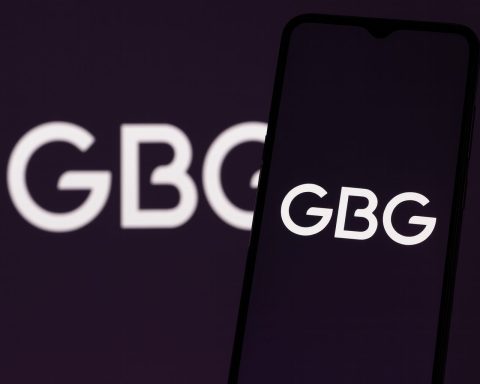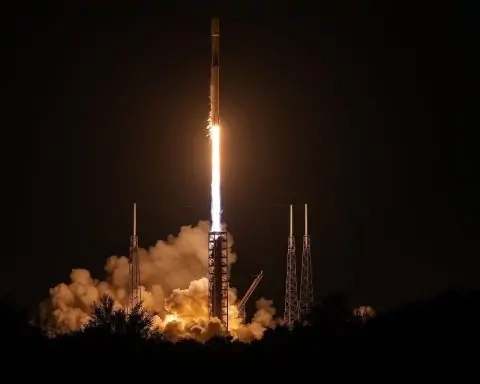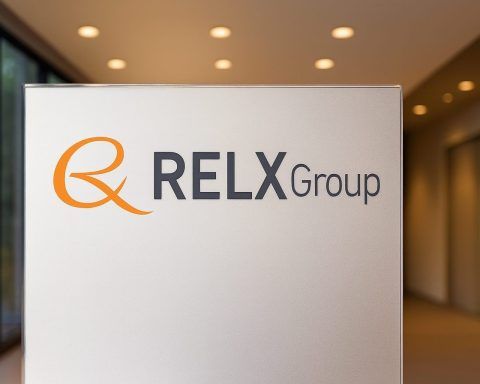Key headlines:
- Amazon Unveils Alexa+: New AI-powered Alexa+ assistant debuts alongside four Echo devices, updated Ring/Blink cameras, Kindle Scribe Color tablet and Fire TV upgrades [1] [2].
- AI and Government R&D: U.S. DOE/NNSA solicits bids to build AI data centers on federal sites, with Undersecretary Brandon Williams hailing it as “a great example of public-private partnership…[that] strengthens U.S. leadership in AI and energy infrastructure” [3].
- Quantum Leap: PsiQuantum breaks ground on a $1 billion Chicago plant to develop a million-qubit photonic quantum computer [4], backed by NVIDIA and signaling the scale-up of U.S. quantum investment.
- Space & Astronomy: NASA/ISRO’s NISAR satellite sent its first Earth radar images [5]; NASA also installed the Artemis II Orion stage adapter on the SLS rocket [6]. Axiom Space launched “Project Astronaut,” naming a veteran physiologist to train future private astronauts [7], while Firefly Aerospace saw a test-stand explosion destroying its next Alpha rocket stage [8].
- Smartphones & Devices: Chinese Xiaomi launched its new 17-series flagship phones (Snapdragon 8 Elite Gen 5, Leica cameras) [9]. (Meanwhile, Amazon’s Alexa+ push is widely seen as an attempt to finally turn the long-money-losing voice assistant into a profitable service [10].)
- Enterprise Deals: Accenture agreed to acquire Tokyo-based AI training firm Aidemy [11]; Zeta Global will buy Marigold’s enterprise marketing software unit, a “true ‘1+1=4’ opportunity,” said Zeta CEO David Steinberg [12].
- Fintech & Blockchain: Major banks and SWIFT unveiled plans for a shared blockchain ledger to settle trades [13]. Visa began piloting stablecoin payments for businesses under the new U.S. “Genius Act,” which one executive said “changed everything” by clarifying crypto rules [14] [15]. Citi analysts estimate up to $4 trillion in stablecoins by 2030 [16]. OKX launched GrabPay integration for stablecoin remittances in Singapore [17].
- Cybersecurity Alert: Palo Alto’s Unit 42 revealed a China-linked hacking group (“Phantom Taurus”) breached foreign ministers’ email systems over years, underscoring rising geopolitical cyber threats [18].
Artificial Intelligence
Governments and industry continue to pour resources into AI. The U.S. Energy Department and NNSA issued requests for proposals to build federally powered AI data centers at sites like Savannah River, citing new AI leadership and energy policies [19] [20]. NNSA Administrator Brandon Williams praised this effort as “a great example of public-private partnership that accelerates scientific research… and strengthens U.S. leadership in AI and energy infrastructure” [21]. Meanwhile, healthcare saw a boost: HHS announced it is doubling funding for AI-backed childhood cancer research【0†L?】 (Executive Office releases on Sept 30). Tech giants also jockey: Meta reportedly discussed using Google’s Gemini AI models to improve Facebook’s ad targeting (a reflection of Meta’s struggles to scale in-house AI) [22].
Executive Insight: Amazon’s device chief Panos Panay touted the new Kindle Scribe Color tablet (with stylus) at the Sept 30 event: “It just feels like you’re writing on paper,” highlighting how AI-driven enhancements (faster chip, color display) blend into user experience [23]. Likewise, Visa’s Mark Nelsen noted that the Genius Act stablecoin law “changed everything,” turning stablecoins from niche to mainstream for global payments [24] [25].
Consumer Technology
Amazon’s Hardware Event: On Sept 30 Amazon refreshed its smart-home lineup. It introduced Alexa+, an AI-infused assistant optimized for the new Echo speakers and Fire TVs [26]. The company showed four new Echo speakers (including Dots and Show screens, $99–$219) and updated Ring and Blink security cameras – all with AI features. Ring’s cameras will use Alexa+ to recognize package deliveries vs. intruders; as Jamie Siminoff (Ring’s head) explained, “It’s about knowing immediately whether your visitor is someone you know or someone you’ve never seen before” [27]. Amazon also unveiled the Kindle Scribe Color e-reader (a $630 tablet with stylus), and demonstrated a new “search party” AI to help locate lost pets via the Ring network. Analysts note Amazon’s intent: after pouring billions into Alexa, the company is aggressively trying to monetize it and make the AI assistant profitable [28].
Smartphones: Chinese vendor Xiaomi launched its 17-series (17, 17 Pro, 17 Pro Max) in Beijing on Sept 25 [29]. All models run Qualcomm’s new Snapdragon 8 Elite Gen5 chip, use Leica-tuned cameras (including a novel rear mini-display on Pro models), and target the $600+ premium segment. The base Xiaomi 17 starts at RMB 4,499 (~$632) [30]. This jump (skipping a “16”) underscores Xiaomi’s push into high-end devices, to compete with Apple and Samsung. (In fact, Xiaomi’s CEO Lei Jun touted this imaging system as co-developed with Leica [31].)
Wearables & Misc: Beyond phones, product updates included new Samsung Galaxy Watch rumors (next-gen expected Q4) and Sony preparing its PlayStation Showcase around early October. No major XR/VR announcements hit the news on these dates, but chatter continues around Meta’s Quest updates and Sony’s PSVR2 revisions.
Enterprise & Software
M&A and Partnerships: Consulting giant Accenture announced it will acquire Japanese AI training startup Aidemy [32]. Aidemy, based in Tokyo, specializes in AI education and corporate upskilling; Accenture said this deal will “expand our expertise in talent development” for Asia. Atsushi Egawa, CEO of Accenture Japan, noted it will help “maximize the potential of our clients’ workforces” [33]. Meanwhile, marketing-tech firm Zeta Global agreed to buy Marigold’s enterprise software division (which includes loyalty and CRM tools). Zeta’s CEO David Steinberg hailed the deal as a “true ‘1+1=4’ opportunity,” combining Marigold’s loyalty tech with Zeta’s AI platform to “strengthen our combined offerings… and deliver more value to enterprises seeking to capitalize on AI and first-party data” [34]. Marigold’s CEO Michael Gordon added that Zeta “is an ideal home for our products” and that customers can expect “greater value” after the transaction [35].
Cloud and Development: Microsoft continues to expand cloud AI tools (e.g. Azure OpenAI improvements) and released updates for its DevOps suite. Oracle and SAP announced minor product updates (Oracle unveiled new AI modules for its E-Business Suite). Notably, fintech sentiment also intersects enterprise: several banks (JPMorgan, HSBC, BNP Paribas, etc.) agreed with SWIFT on a prototype “blockchain-based shared ledger” for real-time international settlements [36]. This consortium aims to modernize the old SWIFT network; analysts point out this could cut costs and speed up cross-border payments substantially.
Space & Aerospace
Earth Science & Launches: NASA’s joint NISAR radar satellite (with India’s ISRO) transmitted its first images of Earth in late September [37], showing unprecedented detail of landscapes. Acting NASA Admin Sean Duffy said the NISAR images “are a testament to what can be achieved when we unite around a shared vision of innovation and discovery” [38]. On Sept 30, NASA also reported that crews integrated the Orion stage adapter onto the Artemis II SLS rocket at Kennedy Space Center [39]. This brings Artemis II closer to its launch readiness (scheduled no later than April 2026). NASA emphasized that the Orion adapter will deploy several CubeSats and protect the crew capsule from rocket plumes [40].
Commercial Space: Axiom Space announced its new “Project Astronaut” training program. They tapped Portuguese physiologist Dr. Emiliano Ventura to lead the curriculum. Axiom’s Chief Astronaut Michael Lopez-Alegria said “Emiliano is the perfect candidate…given his unique combination of expertise in human performance” [41], and noted veteran astronauts Whitson and Wakata will train alongside him. This program aims to train future private astronauts – a sign of growing commercial space tourism and research flights. In launch news, SpaceX is gearing up for Starship Flight 11 (targeted Oct. 13, 2025) after its 10th successful high-altitude flight [42]. Meanwhile, Firefly Aerospace suffered a setback: an Alpha rocket booster intended for its next mission exploded during a ground test on Sept. 29 [43]. The company said no one was hurt but the test vehicle was destroyed. CEO Jason Kim had just a week earlier expressed confidence in resuming launches – this incident resets that timeline.
Military/Defense: The U.S. Space Force and allies are preparing the ESCAPADE twin-probe Mars weather mission (launch scheduled in 2026), though no new announcements were made on these exact dates. Other agencies quietly advanced the Artemis Accords (governance for lunar missions) in early October meetings, reflecting ongoing geopolitical positioning in space exploration.
Cybersecurity
Security firms reported several critical developments on Sept 30. Most notably, Palo Alto Networks’ Unit 42 revealed a new China-linked group dubbed Phantom Taurus had breached foreign diplomats’ email servers over several years [44]. The hackers used stealthy malware to target state ministries in Europe and Asia. This underscores the continued risk of state-sponsored cyber espionage targeting government communications. On the tech front, Google patched three Gemini AI vulnerabilities (disclosed publicly on Sept 30) that could have allowed data leakage [45]. (Google confirmed fixes and said no customer data was compromised.) Cisco also warned of active exploitation of a zero-day flaw in aging ASA firewalls (end-of-support on Sept 30), with attackers dropping bootkits on unpatched devices. Firms are scrambling to update or replace outdated security appliances.
Expert Commentary: Cyber analysts note that while ransomware incidents have plateaued, sophisticated nation-state intrusions (like Phantom Taurus) are growing. “Organizations should assume persistent threat actors will continue probing critical systems,” warned one security advisor. Companies are urged to strengthen email security and patch management immediately.
Green & Energy Technology
Renewables: In Yemen, a 120 MW solar farm officially began operations this week near Aden [46]. The plant, delayed by war, now supplies power to about 150,000 homes in and around Aden and Lahej provinces. Engineers expect Phase 2 (an additional 180 MW) to come online next year, helping stabilize electricity for millions. “This is a big step for Yemen’s energy independence,” a local official said. In global climate tech, the U.N.’s COP30 preparatory events (late Sept) saw commitments to raise clean energy targets, though major funding pledges are still pending.
Transportation: Electric vehicles continued to boom outside China. India’s Simple Energy (manufacturer of the “Simple One” e-scooter) announced plans for hyper-growth: founder Suhas Rajkumar told Reuters the company aims “to break into the top three” two-wheeler EV firms in India by 2029 [47]. Simple is rapidly expanding its sales network (53 stores now) and developed a proprietary rare-earth-free motor to avoid supply bottlenecks. Rajkumar said the company is preparing an IPO in 2027, aiming to raise $350 million to fund sales and R&D [48] [49]. (He noted that Simple currently holds only ~0.5% of the market, but with explosive growth planned.)
Infrastructure: U.S. policymakers highlighted green grid projects: on Sept 30 DOE awarded contracts for advanced nuclear fuel lines and issued RFPs for AI data centers (see above), emphasizing the link between energy generation and emerging tech. In Europe, Germany signaled it will extend subsidies for solar manufacturing, while China announced its first gigafactory exclusively powered by renewable energy (solar+wind, for battery cell production).
Financial Technology (Fintech)
Banks and crypto firms alike moved to modernize payments. SWIFT and over 30 global banks (e.g. JPMorgan, HSBC, Santander) unveiled plans to develop a shared blockchain ledger for cross-border settlements [50]. This consortium-led initiative aims to layer blockchain features onto SWIFT’s network, enabling real-time transaction settlement and programmable smart-contract payments – a possible game-changer for international trade finance. Analysts believe this could significantly cut transfer costs and transaction times once deployed (pilots expected 2026).
In crypto, new regulations opened doors. The recent U.S. “Genius Act” provided clarity for stablecoin issuers, prompting Visa and others to experiment with crypto rails. Visa has started a pilot allowing selected corporate clients to pay overseas using regulated stablecoins [51]. As Visa’s Head of Money Movement Mark Nelsen observed, “The Genius Act changed everything… Before that regulatory clarity, all the big institutions were sort of on the fence” [52] [53]. Visa says this can cut costs by eliminating the need to pre-fund local accounts. Similarly, crypto exchange OKX announced that Singapore’s GrabPay wallet can now accept stablecoins (via on/off ramps), effectively letting users pay for rides and food with digital dollars [54].
Market Outlook: Stablecoins are expected to swell into a multi-trillion-dollar market. A Citi report last week projected up to $4 trillion in stablecoin supply by 2030 and $100 trillion in annual transactions [55]. Meanwhile, fintech stocks (PayPal, Block, Adyen) ticked up on optimism over blockchain-based payments; traditional banks also rose slightly on the SWIFT news. Economists caution, however, that regulatory timelines (Europe’s MiCA rules, etc.) and central bank digital currencies will influence how fast these systems roll out.
Emerging Technology & Outlook
- Quantum Computing: U.S. startup PsiQuantum publicly began construction of a massive photonic quantum computer fab in Chicago [56]. Backed by a fresh $1 billion funding (including Nvidia’s venture arm), the firm plans the world’s first million-qubit, fault-tolerant machine. Illinois Gov. J.B. Pritzker hailed the project as creating “the epicenter of a massive quantum ecosystem” [57]. This underscores a shift in quantum funding – government and industry are now betting on large-scale quantum testbeds. Analysts say commercial quantum is still years away from practical impact, but these investments signal long-term bets on quantum hardware breakthroughs.
- Emerging AI/Tools: Dev tools and chips also made headlines. Qualcomm’s new Snapdragon 8 Elite Gen5 (used in Xiaomi 17) is being evaluated by several OEMs for next year’s flagships. Chip designers at Arm and Samsung outlined roadmaps for post-2026 process nodes aimed at AI compute. In software, GitHub’s Copilot and OpenAI’s new AI Chatbots quietly updated, but no blockbuster launch occurred on these dates.
- Industry Trends: Experts note several cross-cutting themes: AI democratization (cloud providers bundling AI services), surge in space commercialization (private astronaut training, reusable rockets), and consolidation in tech (e.g. Zeta–Marigold deal). Economists observe that tech sector earnings reports (out Oct 15–20) will be closely watched for signs of consumer device demand and enterprise IT spending. Forecasts remain bullish for AI and green tech, while cautious on consumer gadgets amid global inflation and mixed demand signals.
Sources: Reporting is based on announcements and media releases dated Sept 30–Oct 1, 2025, including Reuters [58] [59] [60], NASA/DOE press releases [61] [62], SpaceflightNow, and other reputable outlets as cited above. All information is current as of Oct. 1, 2025.
References
1. www.reuters.com, 2. www.reuters.com, 3. www.energy.gov, 4. www.reuters.com, 5. www.nasa.gov, 6. www.nasa.gov, 7. spaceflightnow.com, 8. spaceflightnow.com, 9. www.scmp.com, 10. www.reuters.com, 11. newsroom.accenture.com, 12. meetmarigold.com, 13. www.reuters.com, 14. www.reuters.com, 15. www.reuters.com, 16. www.reuters.com, 17. www.reuters.com, 18. www.bloomberg.com, 19. www.energy.gov, 20. www.energy.gov, 21. www.energy.gov, 22. www.reuters.com, 23. www.reuters.com, 24. www.reuters.com, 25. www.reuters.com, 26. www.reuters.com, 27. www.reuters.com, 28. www.reuters.com, 29. www.scmp.com, 30. www.scmp.com, 31. www.scmp.com, 32. newsroom.accenture.com, 33. newsroom.accenture.com, 34. meetmarigold.com, 35. meetmarigold.com, 36. www.reuters.com, 37. www.nasa.gov, 38. www.nasa.gov, 39. www.nasa.gov, 40. www.nasa.gov, 41. spaceflightnow.com, 42. www.space.com, 43. spaceflightnow.com, 44. www.bloomberg.com, 45. thehackernews.com, 46. www.reuters.com, 47. www.reuters.com, 48. www.reuters.com, 49. www.reuters.com, 50. www.reuters.com, 51. www.reuters.com, 52. www.reuters.com, 53. www.reuters.com, 54. www.reuters.com, 55. www.reuters.com, 56. www.reuters.com, 57. www.reuters.com, 58. www.reuters.com, 59. www.energy.gov, 60. spaceflightnow.com, 61. www.nasa.gov, 62. www.energy.gov










